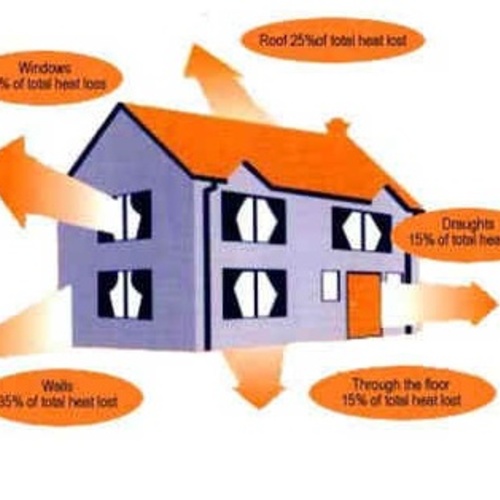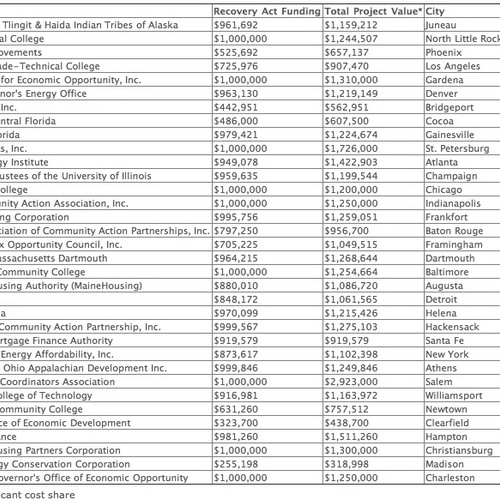
The operative concept behind the recently released Recovery Through Retrofit Report, which GBA discussed briefly last week, is that stimulus-funded energy efficiency initiatives focused on home weatherization should become self-sustaining.
The report, which the White House released on October 19, identifies three barriers to the formation of a national retrofit market and three strategies for overcoming those barriers. The document does not, however, advocate spending more money than the approximately $80 billion that has already been approved for energy efficiency and environmental-improvement programs through the American Recovery and Reinvestment Act. Rather, it identifies ways that existing programs might be improved and augmented to perpetuate the retrofit market.
For the most part, the Retrofit Report draws on ideas that are already being successfully implemented in various parts of the country – ideas that are viewed by the White House Council on Environmental Quality (CEQ), which led the way in writing the report, as prime candidates for standardization and nationwide deployment.
The three barriers:
1. Poor consumer access to straightforward and reliable information on home energy retrofits;
2. Inadequate access to retrofit financing; and
3. Too few skilled workers and green entrepreneurs to expand weatherization and efficiency retrofit programs on a national scale.
Energy Star’s expanded role
The Retrofit Report response to the first problem is to develop a national energy efficiency performance standard for existing homes akin to the Environmental Protection Agency’s Energy Star program, which rates new homes and appliances. (The Energy Star system for new homes has been criticized as insufficiently stringent by contemporary standards, and the Environmental Protection Agency is in fact developing new guidelines, collectively known as the 2011 Specification, that are designed to take a more assertive approach to new-home performance.)
The Retrofit Report team, led by Vice President Joe Biden’s Middle Class Task Force and the CEQ, proposes developing this new Energy Star program “in partnership with industry leaders, realtors, and efficiency advocates to promote widespread adoption,” and then marketing the program widely. The EPA, the Department of Energy, the Department of Housing and Urban Development, and other agencies already are developing prospective performance measures and measurement tools.
Taming financing problems
That leads us to the report’s solution to barrier number 2: make it easier for homeowners to identify and access financing tools for energy efficiency retrofits. Currently, there are a variety of financing options out there, but the programs vary from state to state, with some better publicized than others. The DOE Energy Efficiency & Renewable Energy agency’s State Energy Program, through its stimulus-fund grant process, encourages states to develop financing systems, including revolving loan funds, that homeowners can use to make energy efficiency upgrades.
And a number of municipalities have introduced financing packages for energy retrofits that allow homeowners to add the amortized cost of the project to their property tax bill, which guarantees that the loan payments stay with the house rather than with the homeowner should the house be sold. The money for these loans often is raised through Property Assessed Clean Energy (PACE) bond issues. Homeowners tend to favor PACE-funded loans not only because they reduce worry about the prospect of recovering a retrofit investment upon sale of the house, but also because loan transaction costs tend to be lower and the application process simpler.
Many PACE-funded loans, however, have been given “super-priority lien” status, meaning they take priority over whatever private financing a homeowner may have, including a conventional mortgage. The Retrofit Report says that federal agencies will address issues of risk and other concerns with PACE programs with a new set of principals – developed in concert with state and local governments – that will standardize “underwriting criteria and safeguards to protect consumers and minimize financial risks to homeowners and mortgage lenders.” So far under the State Energy Program, the DOE has received approximately $80 million of applications for PACE-type programs, out of about $3.1 billion in available funding, the report says.
Giving EEMs more juice
Once energy performance standards for retrofits are in place, the report says, the Federal Housing Administration will link them to its redesigned Energy Efficient Mortgage products, which offer prospective homeowners who are applying for an FHA loan an additional $4,000 (or 5% of the loan amount, up to $8,000) for energy efficiency upgrades.
The Energy Efficient Mortgage program, meanwhile, also is getting a makeover designed to “expand and increase the effectiveness” of its mortgages. Four improvements are in the offing: development of the aforementioned home energy performance standard; a streamlined home energy audit and rating process; development of Energy Efficient Mortgage products that can be offered by Fannie Mae and Freddie Mac; and development, in collaboration with the home appraisal industry, of an appraisal process that will accurately reflect improvements in energy efficiency attained through a retrofit.
Expanding revolving loan funds
Revolving loan funds created from stimulus funds are now offered in 16 states. The Retrofit Report says the government will encourage their development in the remaining 34 states, and, to make the loans less expensive (the loans are paid off through energy savings attained through retrofits), the loans will come with a few conforming requirements: loan length (up to 15 years); use of Energy Star-approved products; installations completed according to common procedures; and standardized procedures for measuring both the performance of the loans and the energy performance of the retrofitted homes.
Expanding and enhancing the retrofit workforce
In response to the third barrier identified in the report – training and mobilizing more workers for energy retrofit jobs – the CEQ team says the government is once again aiming for consistency, but also for improved training of both workers and retrofit-business managers.
The priorities in this area: advance a nationally recognized worker certification standard; promote a nationally recognized accreditation standard for trainers; develop model training programs that can be replicated widely and that provide aspiring workers a clear path to advancement and job opportunities; and provide business development support and management training to boost the success rate among retrofit firms.
One more challenge: maintaining momentum
The government’s experience with the stimulus-funded expansion of the Weatherization Assistance Program may foreshadow, in a general way, what is in store for the implementation of the retrofit initiatives. Bureaucratic complexities and concerns about preventing fraud meant the expanded WAP would roll out more slowly than people had hoped. But it is finally underway. Making home energy retrofits a long-lasting, stable, national industry – well, it could take a while, especially given the challenges inherent in establishing standards for training, finance, and home retrofit performance.
But we have to start somewhere.
Weekly Newsletter
Get building science and energy efficiency advice, plus special offers, in your inbox.













3 Comments
Stimulus?
My husband who is both a registered architect & a licensed general contractor has ALWAYS designed energy-efficient homes & other buildings LONG BEFORE there was any mention of Energy Star or other "certifications". He has promoted ICF block which greatly increased R values, insulated windows & roofing materials as well as eco-friendly floor treatments for YEARS. All of a sudden it seems that the rest of the world woke up just in time for the biggest economic disaster that has hit our nation in quite some time. The "Stimulus Package" is a joke. No amount of money is going to correct systems & practices that put people, banks and those industries that depend on them at risk. Government has no busienss being in our business. And if anyone thinks that stimulus money will automatically improve "green" industries, I would suggest they reconsider their assumption. I would definitely like to see more environmently-friendly everything - food, farming practices, marketing - as well as in th building trades. I have begun a square-foot garden and try to purchase from local "mom & pop" businesses whenever possible. The real solution is not tons of money disbursed but a whole lot of people taking a stand, speaking up and willing to change their habits. As individuals we are a lot more powerful than what the media/government/politicians have led us to believe.
retrofits and govt involvement
i would like to express support for the govt getting behind the energy retrofit movement. we will need a national scale effort to make a dent in this large opportunity to reduce our energy consumption. granted the govt is a very blunt instrument but better to have them supporting than opposing.
i am a gc building certified green homes and am a BPIcertified building analyst and have worked at the state level to get support for retrofits with mixed results
Sorry Elizabeth
I admire you and your husband for being on the band wagon before it was a band wagon. I too have been at it for over 30 years. I teach green sustainable building, building science and renewable energy.
ICF is great as well as many other building systems, materials, and processes.
I have found it difficult to educate those who are set in their ways. Building professionals at all levels tend to be content with craftmanship of generations past. While I respect the pride of these professionals, I find it hard to open their eyes to immediate need for change.
I think stimulus funded energy efficiency is a must to help get them on board. Also note that this specific stimulus funding is for existing structures and not new construction. This has not been the norm until now. Without education, and stimulus help, how & where should we begin?
Log in or create an account to post a comment.
Sign up Log in